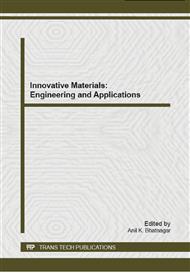[1]
Junan Shen a, c, Serji Amirkhanian b, Feipeng Xiao b, Boming Tang c. Influence of surface area and size of crumb rubber on high temperature properties of crumb rubber modified binders[J]. Construction and Building Materials 23 (2009) 304–310.
DOI: 10.1016/j.conbuildmat.2007.12.005
Google Scholar
[2]
Soon-Jae Lee, Chandra K. Akisetty, Serji N. Amir khanian. Recycling of laboratory-prepared long-term aged binders containing crumb rubber modifier[J]. Construction and Building Materials. 2007, 07, 12: 1-8.
DOI: 10.1016/j.conbuildmat.2007.07.012
Google Scholar
[3]
Shutang Liu a, Weidong Cao, Jianguo Fang, Shujie Shang. Variance analysis and performance evaluation of different crumb rubber modified (CRM) asphalt[J]. Construction and Building Materials. 2008, 12, 9: 1–8.
DOI: 10.1016/j.conbuildmat.2008.12.009
Google Scholar
[4]
Judith C Wang, S M ASCE and Xiangwu Zeng. Influence of Temperature and Pressure on the Dynamic Properties of Rubber-Modified Asphalt Concrete[J]. Journal of Materials in Civil Engineering. ASCE , 2006 , 125: 0899-1561.
DOI: 10.1061/(asce)0899-1561(2006)18:1(125)
Google Scholar
[5]
Navarro, F J, Partal, P Mart ınez-Boza, F Valencia C Gallegos. Rheological Characteristics of Ground Tire Rubber-Modified Bitumens[J]. Chemical Engineering Journal, 2002, 89 (2): 53–61.
DOI: 10.1016/s1385-8947(02)00023-2
Google Scholar
[6]
Navarro F J, Partal P, Martı nez-Boza , F Gallegos. Thermo-Rheological Behaviour and Storage Stability of Ground Tire Rubber-Modified Bitumens[J]. Fuel, 2004, 83 (3) : 2041–(2049).
DOI: 10.1016/j.fuel.2004.04.003
Google Scholar
[7]
Palit, S K, Sudhakar Reddy, K Pandey, B B. Laboratory Evaluation of Crumb Rubber Modified Asphalt Mixes[J]. Journal of Materials in Civil Engineering. ASCE, 2004 , 45: 0899-1561.
DOI: 10.1061/(asce)0899-1561(2004)16:1(45)
Google Scholar
[8]
Feipeng Xiao a, Serji N. Amirkhanian, Junan Shen, Bradley Putman. Influences of crumb rubber size and type on reclaimed asphalt pavement (RAP) mixtures[J]. Construction and Building Materials 23 (2009) 1028–1034.
DOI: 10.1016/j.conbuildmat.2008.05.002
Google Scholar
[9]
Qunshan Ye. Resear on the Rheological Characteristics of Fiber Modified Asphalt Binder and Mixture[D]. Wuhan: Ph D dissertation of Wuhan University of technology, 2007: 40~46.
Google Scholar
[10]
R.L. Terrel, and J.A. Epps, National Asphalt Pavement Association (NAPA): Riverdale, MD, 1989, 114.
Google Scholar
[11]
Soon-Jae Lee a, Hakseo Kim, Serji N. Amirkhanian, Kwang W. Kim. Relation of mechanical properties of recycled aged CRM mixtures with binder molecular size distribution[J]. Construction and Building Materials 23 (2009) 997–1004.
DOI: 10.1016/j.conbuildmat.2008.05.016
Google Scholar


